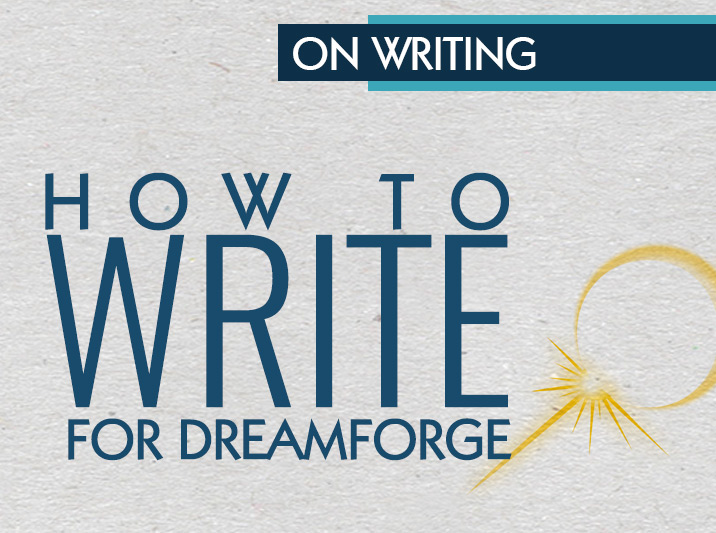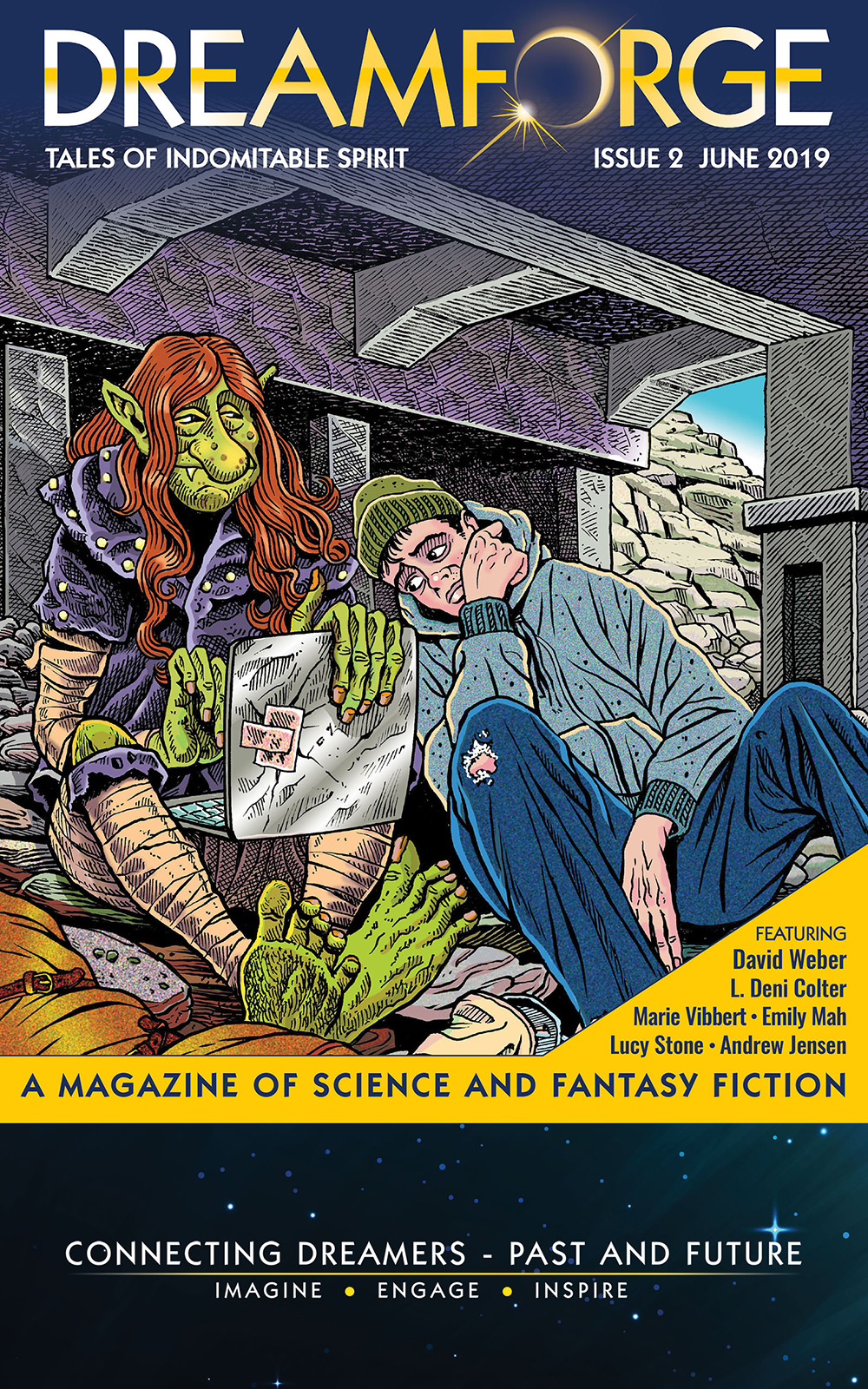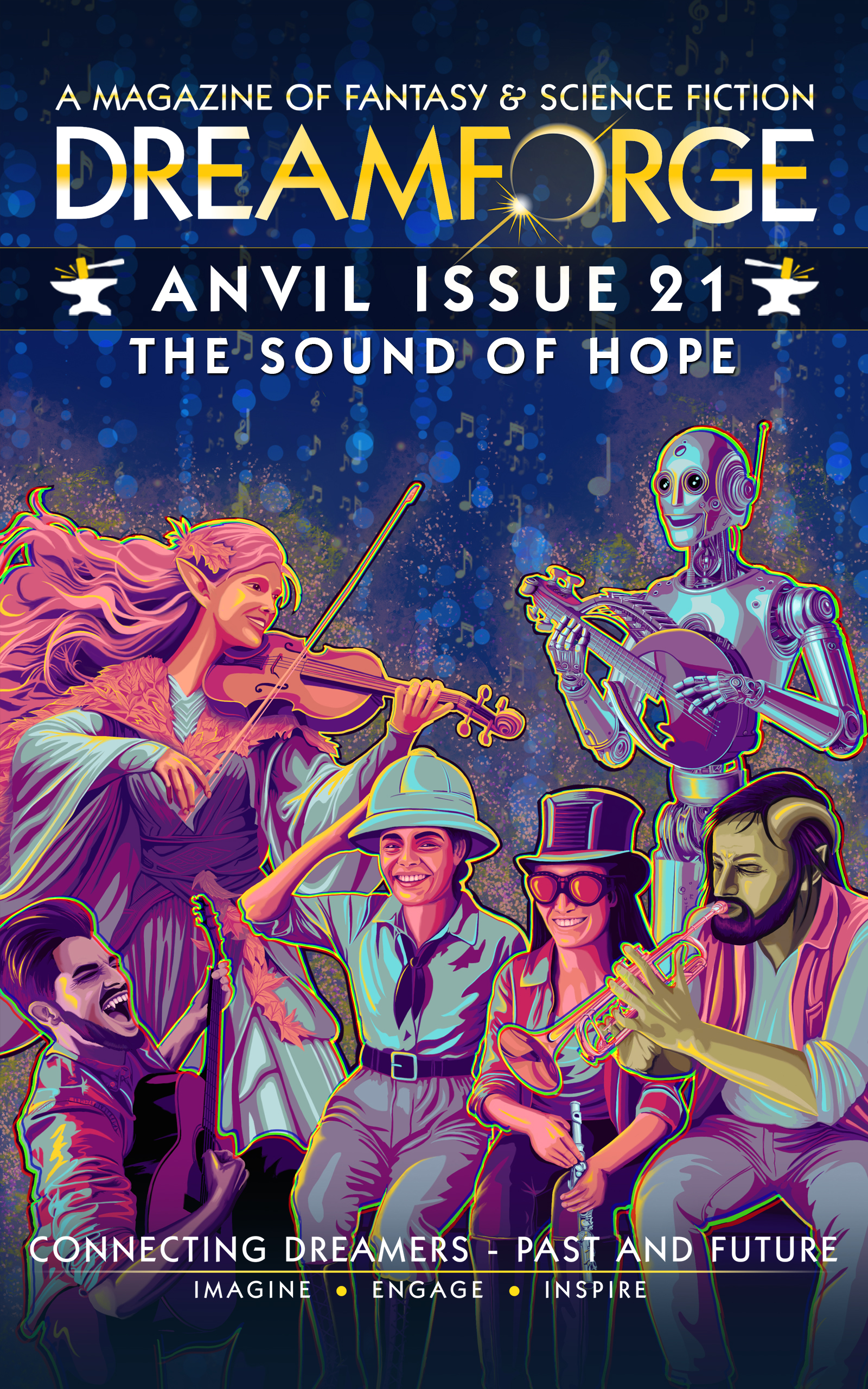
When we opened for our first reading period in the fall of 2018, we received over 200 submissions from all over the world. As I write this, only a third of the way through our second submissions window, we have received over 700 stories and counting, fast.If our task is to read through enough material to fill 30 to 40 magazines and choose only the best for 1 or 2 issues, what exactly are we looking for? At DreamForge, we know that even the most lacking story was sent in on wings of high hope. Why not bolster that hope a little by giving our eager contributors some clues? Afterall, the competition is tough and only getting stronger by the day.
When we bring your story up on our screens, we have high hopes too. We want each new tale to be the one that makes us giddy with excitement, just as if we were panning for gold and suddenly struck it rich. So, what exactly does that gold look like when we see it?
The Good Opening
The first few paragraphs and the first page are critical to catching our attention. They need to be sharp, clear, and engaging. Hook us in and give us a promise of something interesting to come.
“Sid,” by Andrew Jensen (the cover story of this issue), begins as follows:
“The wheel popped off my toy car. That’s how I met Sid.
It wasn’t one of those fancy cars that fall apart on purpose when you crash them. When the wheel popped off, I knew I was in trouble.
Not that anyone would shout at me. They wouldn’t care. No one would get me another car or fix this one either. My car was broken. I was on my own.
The wheel rolled under my bed. I scrambled down fast and tried to grab it before it rolled too far into the dark.
Then I saw the eyes. They were glowing.”
In 100 words, Andrew establishes a character (a young boy we come to know as Adam), a scene, a sense of back story, and immediate peril. Without describing a child’s bedroom, he makes us understand it’s a child’s bedroom. Without saying anything about the child’s socio-economic status, he tells us exactly what that status is. It’s a great opening, and I want to read more.
The Bad Opening
Openings that shut us down almost as soon as we see them, go something as follows. (Don’t worry, I made one up fairly quickly, no need to embarrass anyone.)
“The energy beams lanced into the mighty space cruiser Indefatigable, causing the bridge deck to shudder with the impact. Commander Olivia Redstone surveyed her loyal crew with steely, determined eyes as sparks flew from the nav panel and flames erupted from the engineering controls.
Only last week they had all been on shore leave together on the planet Graxcredical Suprovana, where, as half the galaxy knows, the saying is “Drist Bradagan Purtensis,” all or nothing in the face of overwhelming odds! They had spent their days drinking the brown, bubbling mead of the many cave-pubs and their nights ensconced in the gambling dens of the embittered Prince Dugomere.
Another explosion rocked the ship, but Redstone only smiled, supremely confident that in the next few moments, her ship could turn the tables on the bushwhackers whose as yet invisible ships remained hidden in the nebula to port.”
There you go.
Whether you’re writing fantasy or hard SF, bring a little research and understanding to your topic. Energy beams do not hit with physical force, and except on TV spaceships, circuit breakers were invented a long time ago
More importantly, physical action for the sake of physical action is generally not a good hook. I don’t care how fast the car is going or how many swords have clashed.
Do not make me read hard words because they were fun for you to type, in any language, even if they are real words. (And when you do, make it later in the story and make it count.)
Do not give me backstory that immediately breaks my engagement and provides a history lesson. More than a few submissions delighted us with a perfectly good opening hook and then immediately devolved into a complex backstory that no one cared about, not even the characters, I swear!
While the threat appears to get worse, the protagonist either doesn’t care, or you just told me she is in no real danger. Don’t do that!
In all tales, across all genres, we care about people who are in trouble and they know it, however fearlessly they may present themselves to the world. A mother trying to protect her child from village raiders; a teenager who has accidentally killed an alien; a starship captain who must choose between the man he loves and the sister whose criminal enterprise will save their world.
Whatever it is, give me pain, uncertainty, and fear, especially if it’s clear and simple and I feel like I could be there in that same sort of trouble. You’ll have me hooked. The time to introduce complexity that enriches the experience of the narrative is not at the beginning.
Point of View
Someone, I presume, is your point of view character —the protagonist— a person or creature in empathy with whom we are about to experience the adventure you’ve prepared for them.
Your character may not be human, but your readers are. We need human emotions and points of view with which to orient ourselves and enter your tale on solid ground.
Again, from this issue’s “Sid:”
“Thanks,” said the not-monster. “I gotta go. My mom can be really mean if I’m late for supper.”
I was hungry. “What’s for supper?”
“Fish. It’s always fish. See you around.” The glowing eyes blinked out. There was no one under the bed anymore.
In this scene a young boy is talking to a monster under his bed, a troll in fact. Yet we clearly have a very human interaction. The author builds on it later to bring out the differences between trolls and humans, but by then our empathy has been engaged and we actually care about this under the bed intruder.
“Using the fifth essence, Grtacororex consulted the thousand nodes of his centipede-like feet, each with its own opinion about whether to fight or flee, as every single limb spanned both a past and future equipotential. The task ahead would be difficult, as humans understood nothing of the fifth essence and walked on but two, stone-dumb feet.”
In the example above, there is nothing allowing me to orient myself in a human experience.
Imagine if the movie “Arrival” had been told from the aliens’ point of view. The fun was experiencing the adventure through the eyes of linguistics professor Louise Banks as she fought against her own limitations and the interference of her superiors to gain a critical understanding of why the extraterrestrials had appeared.
The aliens in “Arrival” experienced both language and time differently than humans – telling the story from their point of view would have been maddening and somewhat incomprehensible, and yet we see contributors trying to pull that impossible trick again and again.
Even if your character is a human in a cyberpunk world, it’s hard to follow a protagonist who is having her own thoughts, interfacing with the neural net, and arguing with a secondary sub-mind chattering away in the background at the same time. Give me a point of view character from whose ordinary perceptions you can step away to reveal the magically weird world you want to invite me into.
Believe it or not, alien environments work the same way. Focus on a comprehensible human experience or activity first, then step back slowly to unveil the marvels.
In Larry Niven’s “Smoke Ring,” the story takes place in a torus of atmospheric gases circling around a neutron star. For me, the ring is among the strangest and most marvelous environments ever conceived. Humans live on spinning integral trees, water is found orbiting in spherical lakes and asteroid sized oceans, and the native life forms have trilateral symmetry. Yet when we first experience human characters, they are swimming, fishing, and worrying about the kids getting into trouble in the water. These are recognizable experiences, from which the narrative pulls back with deft movements to bring a truly alien environment into focus.
Start with the ordinary; start with the average man or woman in pain, and pull back to reveal the wonders.
Development of Tension
Now that you have an opening, a hook, and a point of view, it’s important to quickly develop tension. Unfortunately, my attention span is short and my interest is fickle. Hmm… sounds like a lot of readers I know.
In “Sid,” what you might think of as “Scene Two” starts immediately after the opening, and within another 100 words I’m oriented to the scene and I know there’s going to be trouble.
“I was a couple of years older, and I was alone in the woods. I wasn’t supposed to be, but my bike had a flat tire, and I wasn’t going to walk all the way around when I could take a short cut.
The woods weren’t scary like the fairy-tale kind. There were no big bad wolves. I just had to worry about the poison ivy and the piles of rusted metal everywhere.
There were older kids, too. They had BMX trails with jumps over big rocks and jagged pieces of trash. They were scary. You didn’t want to mess with them.”
Make that moment of tension enough to keep me reading until there’s a resolution, after which another moment of tension occurs and the next, even bigger problem, occurs.
In “Sid,” that first resolution is easy. Adam meets up with Sid again.
“I felt better walking with Sid the Troll beside me. I wasn’t so worried about the other kids.”
After this we learn a bit more about Adam’s abusive mother and difficult life, a childhood friendship begins to blossom between Adam and Sid, but soon, back in the woods:
“Yeah, this is it.” He started digging with his bare hands.
After a short time, something showed up under the dirt. It was lighter in color, and sort of smooth. Too smooth to be a rock.
“Is that a skull?” I asked, horrified.
“Yeah. Some little kid got into the woods, and those bike kids found her. What they did to her was awful. I heard some of it. They buried her here. They laughed about the idea of jumping their bikes over her body.”
As the story develops, the problems get deeper and more complicated, breaking Sid and Adam apart and leaving Adam to travel a rough road into young adulthood. The problems peak when Adam is in an accident, one of his own causing, that almost takes his life.
Backstory
Your characters have a history and possibly a destiny. It’s important for you to know those timelines and critical junctures to some degree; they are important to the reader only in so far as they affect the current story, helping us to empathize with the situation and understand the choices being made.
Even though backstory can be critical at times, it can be a deadly bore unless you do it well. Every time you stop to explain the past to me, you run the risk of losing my short and fickle attention.
Between Adam and Sid, backstory is often handled in engaging little conversations that reveal character in meaningful ways. Adam starts off and Sid follows:
“Dorothy, the Scarecrow and the Tin Man were going into these creepy woods, and they were scared of the dangerous animals. Lions and tigers and bears. Get it?”
“My mom’s taught me about bears. There aren’t any here. What are lions and tigers?”
I was stunned. Who didn’t know about those animals?
“Haven’t you seen any movies? Or read about them in books?”
“I had a book once. It didn’t last too well in the swamp. I did learn some letters, though, before it fell apart. ‘A is for Apple.’” He said proudly.
I finally understood. “You’re being home-schooled, aren’t you?”
Sid shrugged. “I guess. My mom’s the only one who teaches me anything.”
I’d heard of kids who were home-schooled. It made sense in Sid’s case: he was so ugly that everyone would bully him. Still, I felt sorry for him. I’d hate it if my mother was my teacher too.”
Another technique used in “Sid” is Adam’s own internal musing as the viewpoint character.
“All of a sudden I felt awful. I thought about how I kept wrecking everything in my life. I’d quit school. The closest thing I had to a friend was a troll who I almost never saw, and everyone said was imaginary. I’d stolen a car. I’d wrecked my stolen car. Couldn’t I do anything right?”
Though engaging dialog and internal musings can be successful ways to introduce a character’s past, I feel compelled to provide an important warning:
NEVER have characters explain in dialog things that should be obvious to themselves or others.
“As you know, George, the hyperbolic inverter was never meant for use this close to a neutron star.”
When it comes to backstory, keep it short; keep the narrative flowing, and sprinkle in a few hints of this and that, here and there, like spices that add to the flavor of a tasty dish. If it feels like you just stopped the forward movement of the story to provide a history lesson, don’t do it.
Difficulties Mount Until it is Life or Death
In “Sid,” every new situation in which we find Adam is more problematic than the last, until the young man is involved in a car crash and severely injured, though he doesn’t know how badly he has been hurt at first.
“Anyway, blowing a front tire on a back road is a bad thing. I ended up rolling the car into a deep ditch. There was a lot of water in it, so I crawled out the shattered windshield as fast as I could. I did manage to hang on to one of the bottles of vodka, though.”
Luckily, Adam has crashed near a bridge where Sid is working. They meet again, and when it becomes obvious how bad off his human friend is, Sid gets him to a hospital. A few snippets of their conversation show that things are coming to a head between them.
“You called 911!” It’s hard to whisper a shout, but I tried.
“I thought you were going to die! You people are so easy to break.”
“I’d be better off dead.”
“You don’t mean that.”
“Yes, I do. Go away. I never want to see you again.”
Interestingly, the life or death decision critical to the resolution of the story is neither made under the bridge nor in the hospital scene to come, but happens “off screen,” in a private moment of Adam’s that we are not privileged to experience with him. It is implied and referred to when we (and Sid) next catch up with Adam working in a salvage yard. Adam explains:
“When you called for help. I could have died there, under the bridge. But you wouldn’t let me. And then those people you called, the ones I was so mad about, they made me stop and figure out what I could do. I love welding things, but I never had the chance to find that out before. Because of you, I got that chance.”
Adam’s life or death decision, of course, was not that he was given a chance, but that he at last recognized and took the pivotal chance that would save his life and give it meaning. By its structure, the story makes clear that the relationship between Sid and Adam had everything to do with that decision; there was no need for us to see the exact moment of the decision; we had already experienced everything necessary to make it true.
Final Resolution and Denouement
Once the corner has been turned, the final issue resolved, it’s time to wrap things up. In “Sid,” once we know that Adam has become a welder and is in love with his art, the story is over. We no longer need to worry about him ever again, and we know his friendship with the troll who first appeared under his bed will continue for a lifetime. The story simply needs to bring this together and make us feel good about it.
“I reached behind a large statue, and pulled out my shiniest creation.
“It’s a suspension bridge,” said Sid, uncertainly. “It looks like it was made from a grocery cart.”
“It’s amazing what new things you can make out of old trash.”
“I hate bridges,” said Sid, thoughtfully.
“I know,” I said.
“Bridges are bad for the life underneath. It gets ignored, or wrecked.”
“I know.”
Sid was silent for a while.
“But this isn’t a real bridge, is it? It’s a symbolic bridge.”
“With real details. I was very careful about that.”
“Symbolic bridges I can live with. Thanks.”
Sid held out his huge, clawed hand. We shook.”
There’s a little more to the final paragraphs of “Sid,” but you get the idea.
It Sounds so Easy, but….
Some stories will be subtle in applying these rules, while others may appear to violate them completely. Masterful writers can bend reality and the rules of storytelling almost anyway they want. Of course, most of the authors crafting words at that level aren’t writing for us, you are – and we wouldn’t have it any other way! You are a part of our community, and we’re rooting for your success. Apply some of our advice and recommendations and we’ll be very excited to read your next attempt.
Or course, there’s still a lot of ground to cover, so be sure to catch Issue # 3. We haven’t really talked about what we mean by a positive theme, or delved much into Character, Background, Conflict, or Plot, except to touch on them tangentially. The adventure has only begun.
Visit https://dreamforgemagazine.com/call-for-submissions/ to learn more, especially about our theme and acceptable manuscript formats.












